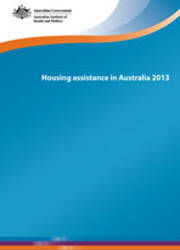Summary
Having a safe place to live is important to all Australians. Stable and secure housing contributes to a range of essential benefits including shelter, health, wellbeing, stable employment and financial security for its occupants. Yet not everyone has access to stable and secure housing within their means; housing is one of the highest costs for most Australians, and a large number of Australian households are experiencing housing stress.
Australian governments and many community-based organisations assist households struggling to meet housing costs through a range of programs, collectively referred to as housing assistance. Housing assistance encompasses the provision of housing, rent assistance, home purchase assistance and services that support maintaining tenancies.
Housing in Australia
- Demand for housing is expected to increase over the next 20 years. There were about 7.8 million Australian households living in private dwellings in 2011, which is estimated to increase by 49% to 11.6 million by 2031.
- The average cost of housing has increased substantially over the past decade. National house prices increased 147% between 2001 and 2011-from $169,000 to $417,500.
- The proportion of Australian households in housing stress has increased, from 14% in 1994-95 to 18% in 2011-12. Of these, 2 in 5 (42%) were low-income households.
Financial assistance with housing costs
- A large number of renters in Australia are receiving financial assistance to reduce rental stress. As at 30 June 2012, about 1.2 million recipients were receiving assistance under the Commonwealth Rent Assistance Program. Additionally, states and territories provided private rent assistance to an estimated 107,000 households in 2011-12.
- Many low-income households and first home buyers received help to purchase their homes. In 2011-12, nearly 41,000 Australian households received support under the Home Purchase Assistance Program. Additionally, 104,000 people received a First Home Owner Grant.
Social housing
- Demand for social housing remains high, and supply is not keeping up. As at 30 June 2012, there were over 200,000 households on public housing or state owned and managed Indigenous housing waiting lists across Australia.
- Supply of social housing has been boosted by the Social Housing Initiative. By 31 March 2013, 19,600 new social housing dwellings were built under the Initiative. In 2013, about 80,000 dwellings had already benefited from repairs and maintenance. In 2011-12, 35,667 households were newly assisted in social housing.
- Social housing continues to be provided to many people in greatest need. In 2011-12, social housing created a pathway out of homelessness for more than 13,000 households, and provided accommodation to 160,000 households with a member with disability.
- Social housing continues to be a stable form of tenure. Over 1 in 3 public housing households and over 1 in 4 state owned and managed Indigenous housing households had been in the same tenancy for over a decade.



